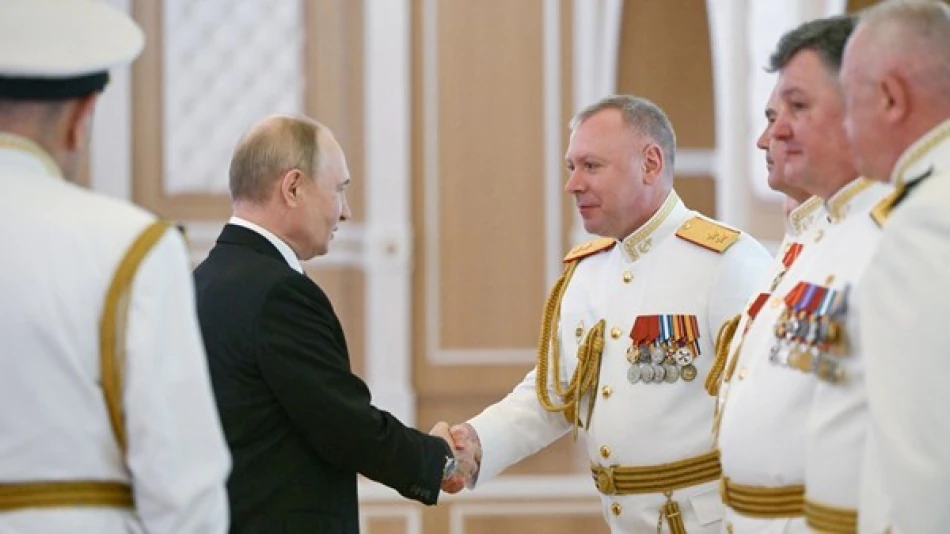
Putin Pledges Continued Combat Training for Submarine and Naval Crews
Putin Doubles Down on Naval Power as Russia Flexes Maritime Muscle During Ukraine Conflict
Russian President Vladimir Putin used the country's annual Navy Day celebrations to emphasize Moscow's commitment to strengthening its maritime forces, signaling that lessons learned from the ongoing Ukraine war are being integrated into naval training. Speaking during the "July Storm" exercises in St. Petersburg, Putin outlined plans for enhanced combat readiness across submarine crews, surface vessels, and coastal defense units—a move that underscores Russia's determination to project naval power despite international isolation.
Strategic Timing Amid Wartime Pressures
Putin's emphasis on naval capabilities comes at a critical juncture for Russia's military. The country's Navy Day, traditionally held on the last Sunday of July, has become increasingly important as Moscow seeks to demonstrate military strength while facing NATO expansion and ongoing conflict in Ukraine. The president's visit to the main naval command headquarters in St. Petersburg was carefully choreographed to project confidence in Russia's maritime doctrine.
The timing is particularly significant given Russia's recent naval challenges, including the loss of the flagship Moskva in the Black Sea and ongoing difficulties maintaining naval operations under international sanctions. By highlighting the integration of "experience gained during the special military operation"—Russia's term for the Ukraine invasion—Putin is signaling that naval forces are adapting their tactics based on real combat conditions.
Naval Modernization as Geopolitical Statement
Beyond Traditional Defense
Putin's stated mission for the Navy—"ensuring Russia's security and protecting its sovereignty and national interests"—reflects a broader strategic shift toward maritime power projection. This approach mirrors China's naval expansion in the South China Sea and echoes historical Russian ambitions to challenge Western naval dominance in key waterways.
The focus on "repelling attacks from the sea" and mastering "complex, non-standard operational and tactical tasks" suggests Russia is preparing for asymmetric naval warfare scenarios. This likely includes defending against potential NATO naval operations while maintaining Russia's ability to project power in regions like the Arctic, where melting ice has opened new strategic corridors.
Economic and Military Implications
For defense contractors and military analysts, Putin's naval emphasis represents both opportunity and challenge. Russian shipbuilding companies may see increased investment, but international sanctions limit access to advanced technologies and components. This could accelerate Russia's push for naval self-sufficiency while potentially widening the technological gap with Western navies.
The enhanced training programs also signal Russia's recognition that modern naval warfare requires more sophisticated crew capabilities, particularly in electronic warfare and missile defense systems—areas where NATO forces have demonstrated superiority.
Regional Power Balance Shifts
Putin's naval modernization push comes as regional powers reassess their maritime strategies. Unlike the UAE's focus on commercial maritime hubs or Singapore's emphasis on naval technology partnerships, Russia is pursuing a more confrontational approach that prioritizes military capability over economic integration.
This strategy carries significant risks. Enhanced Russian naval activities could trigger reciprocal military buildups among Baltic and Black Sea neighbors, potentially destabilizing regions that have seen relative calm since the Cold War's end. For international shipping and energy markets, increased Russian naval assertiveness could create new chokepoint vulnerabilities, particularly in Arctic shipping routes that are becoming increasingly viable due to climate change.
The ultimate test of Putin's naval strategy will be whether Russia can maintain technological parity with Western forces while operating under severe economic constraints—a challenge that will likely define the country's maritime capabilities for the next decade.
Most Viewed News

 Layla Al Mansoori
Layla Al Mansoori






